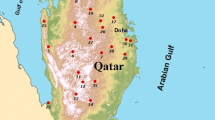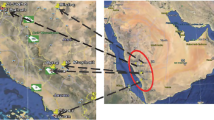Abstract
Design rainfall, often known as intensity–frequency–duration (IFD) data, is an important input in rainfall runoff modelling exercise. IFD data are derived by fitting a probability distribution to observed rainfall data. Although there are many researches on IFD curves in the literature, there is a lack of systematic comparison among the IFD curves obtained by different distributions and methods. This study compares the latest IFD curves in Australia, published in 2013, as a part of the new Australian rainfall and runoff (ARR) with the at-site IFD curves to examine the expected degree of variation between the at-site and regional IFD data. Ten pluviography stations from eastern New South Wales (NSW) are selected for this study. The IFD curves generated by the two most commonly adopted probability distributions, generalised extreme value (GEV) and log Pearson type 3 (LP3) distributions are also compared. Empirical and polynomial regression methods in smoothing the IFD curves are compared. Based on the three goodness-of-fit tests, it has been found that both GEV and LP3 distributions fit the annual maximum rainfall data (at 1% significance level) for the ten selected stations. The developed IFD curves based on the second-degree polynomial present better fitting than the empirical method. It has been found that the ARR87 and ARR13 IFD curves are generally higher than the at-site IFD curves derived here. The median difference between the at-site and regional ARR-recommended IFD curves is in the range of 13–19%. It is expected that the outcomes of this research will provide better guidance in selecting the correct IFD data for a given application in NSW. The methodology developed here can be adapted to other parts of Australia and other countries.














Similar content being viewed by others
References
Australia Bureau of Meteorology (BOM) (2016) How to use the AR and R87 IFD Tool. http://www.bom.gov.au/water/designRainfalls/ifd-arr87/howtoIFDTool.shtml. Accessed 10 Jan 2017
Australian Bureau of Statistics (BOM) (2013) Australia’s climate. http://www.abs.gov.au. Accessed 10 Jan 2017
Ball J, Babister M, Nathan R, Weeks W, Weinmann E, Retallick M, Testoni I (2016) Australian rainfall and runoff: a guide to flood estimation. Commonwealth of Australia, Sydney
Bennett B, Lambert M, Asce AM, Thyer M, Bates BC, Leonard M (2016) Estimating extreme spatial rainfall intensities. J Hydrol Eng 21(3):04015074
Bernard MM (1932) Formulas for rainfall intensities of long duration. Trans ASCE 96(1801):592–624
Dourte D, Shukla S, Singh P, Haman D (2013) Rainfall intensity duration frequency relationships for Andhra Pradesh, India: changing rainfall patterns and implications for runoff and groundwater re-charge. J Hydrol Eng 18(3):324–330
Du H, Xia J, Zeng S (2014) Regional frequency analysis of extreme precipitation and its spatio-temporal characteristics in the Huai River Basin, China. Nat Hazards 70:195–215
Elsebaie IH (2011) Developing rainfall intensity duration frequency relationship for two regions in Saudi Arabia. J King Saud Univ Eng Sci 24:131–140
Fréchet M (1927) Sur La Loi De Probabilité De L’écart Maximum. Journal of Annales De La Société Polonaise De Mathématique 6:93
Garcia-Urquia E (2016) Establishing rainfall frequency contour lines as thresholds for rainfall-induced landslides in tegucigalpa, honduras, 1980–2005. Nat Hazards 82:2107–2132
Green J, Xuereb K, Johnson F, Moore G, The C (2012) The revised intensity-frequency-duration (IFD) design rainfall estimates for Australia. In: An overview in proceedings of the 34th hydrology and water resources symposium, 19–22 November 2012, Sydney, Australia
Greenwood JA, Landwehr JM, Matalas NC, Wallis JR (1979) Probability weighted moments: definition and relation to parameters of several distributions expressible in inverse form. Water Resour Res 15:1049–1054
Greis NP, Wood EF (1983) Regional flood frequency estimation and network design. Water Resour 17(4):1167–1177
Gumbel EJ (1958) Statistics of extremes. Columbia University Press, New York
Haddad K, Rahman A (2014) Derivation of short-duration design rainfalls using daily rainfall statistics. Nat Hazards 74:1391–1401
Haddad K, Rahman A, Green J (2010) Design rainfall estimation in Australia: a case study using L-Moments and generalized least squares regression. Stoch Env Res Risk Assess 25(6):815–825
Haddad K, Rahman A, Green J, Kuczera G (2011) Design rainfall estimation for short storm durations using L-Moments and generalised least squares regression application to Australian Data. Int J Water Resour Arid Environ 1(3):210–218
Haddad K, Johnson F, Rahman A, Green J, Kuczera G (2015) Comparing three methods to form regions for design rainfall statistics: two case studies in Australia. J Hydrol 527:62–76
Hosking JR, Wallis J (1987) Parameter and quantile estimation for the generalized pareto distribution. Technometrics 29:339–349
Hosking JR, Wallis J (1997) Regional frequency analysis: an approach based on L-Moments. Cambridge University Press, New York, p 224
Hosking JR, Wallis J, Wood E (1985) Estimation of the generalized extreme value distribution by the method of probability weighted moments. Technometrics 27:251–261
Institution of Engineers Australia (I. E. Aust.) (1987) Australian rainfall and runoff: a guide to flood estimation. In: Pilgrim DH (ed) Engineers Australia, Canberra
Jakob D, Xuereb K, Taylor B (2007) Revision of design rainfalls over australia: a pilot study. Aust J Water Resour 11(2):153–159
Khan MZK, Sharma A, Mehrotra R, Schepen A, Wang QJ (2015) Does improved SSTA prediction ensure better seasonal rainfall forecasts? Water Resour Res 51(5):3370–3383
Kirkman TW (1996) Statistics to use: Kolmogorov–Smirnov test. College of Saint Benedict and Saint John’s University. Accessed 10 Feb 2010
Landwehr J, Matalas N, Wallis J (1979) Probability weighted moments compared with some traditional techniques in estimating gumbel parameters and quantiles. Water Resour Res 15:1055–1064
Lee C, Kim T, Chung G, Choi M, Yoo C (2010) Application of bivariate frequency analysis to the derivation of rainfall frequency curves. Stoch Env Res Risk Assess 24:389–397
Liong S, Gautam T, Khu S, Babovic V, Keijzer M, Muttil N (2002) Genetic programming: a new paradigm in rainfall runoff modeling. J Am Water Resour As 38(3):705–718
Liu J, Doan C, Liong S, Sanders R, Dao A, Fewtrell T (2015) Regional frequency analysis of extreme rainfall events in Jakarta. Nat Hazards 75:1075–1104
Mamoon A, Joergensen NE, Rahman A, Qasem H (2014) Derivation of new design rainfall in qatar using L-moment based index frequency approach. Int J Sustain Built Environ 3:111–118
Millington N, Das S, Simonovic SP (2011) The comparison of GEV, Log-Pearson type 3 and Gumbel distributions in the Upper Thames River Watershed under Global Climate Models. Raziskovalno poročilo o vodnih sredstvih. London, Ontario, Canada, University of Western Ontario, Department of Civil and Environmental Engineering, p 52
Nhat LM, Tachikawa Y, Sayama T, Takara K (2006) Derivation of rainfall intensity duration frequency relationships for short duration rainfall from daily rainfall data. IHP Tech Doc Hydrol 6:89–96
Overeem A, Buishand A, Holleman I (2008) Rainfall depth duration frequency curves and their uncertainties. J Hydrol 348:124–134
Preacher KJ (2001) Calculation for the Chi square test: an interactive calculation tool for Chi Square tests of goodness-of-fit and independence [Computer Software]. http://quantpsy.org. Accessed 10 Jan 2017
Scholz FW, Stephens MA (1987) K sample Anderson darling tests. J Am Stat As 82:918–924
Verdon-Kidd DC, Kiem AS (2015) Regime shifts in annual maximum rainfall across Australia-implications for intensity-frequency-duration (IFD) relationships. Hydrol Earth Syst Sci 19:4735–4746
Wallis JR (1980) Risk and uncertainties in the evaluation of flood events for the design of hydraulic structures. In: Guggino E, Rossi G, Todini E (eds) Piene e Siccità. Fondazione Politecnica del Mediterraneo, Catania, pp 3–36
Weibull W (1951) A statistical distribution function of wide applicability. J Appl Mech Trans ASME 18(3):293–297
Xu Y, Tung Y (2009) Constrained scaling approach for design rainfall estimation. Stoch Env Res Risk Assess 23:697–705
Yilmaz AG, Hossain I, Perera BJC (2014) Effect of climate change and variability on extreme rainfall intensity–frequency–duration relationships: a case study of Melbourne. Hydrol Earth Syst Sci 18:4065–4076
Yu PS, Yang TC, Lin CS (2004) Regional rainfall intensity formulas based on scaling property of rainfall. J Hydrol 295:108–123
Acknowledgements
The authors would like to acknowledge the Australian Bureau of Meteorology for providing the pluviograph data used in this study. The authors would like to acknowledge the comments and suggestions by the reviewers, which have improved the quality of the manuscript.
Author information
Authors and Affiliations
Corresponding author
Rights and permissions
About this article
Cite this article
Hajani, E., Rahman, A. Design rainfall estimation: comparison between GEV and LP3 distributions and at-site and regional estimates. Nat Hazards 93, 67–88 (2018). https://doi.org/10.1007/s11069-018-3289-9
Received:
Accepted:
Published:
Issue Date:
DOI: https://doi.org/10.1007/s11069-018-3289-9




